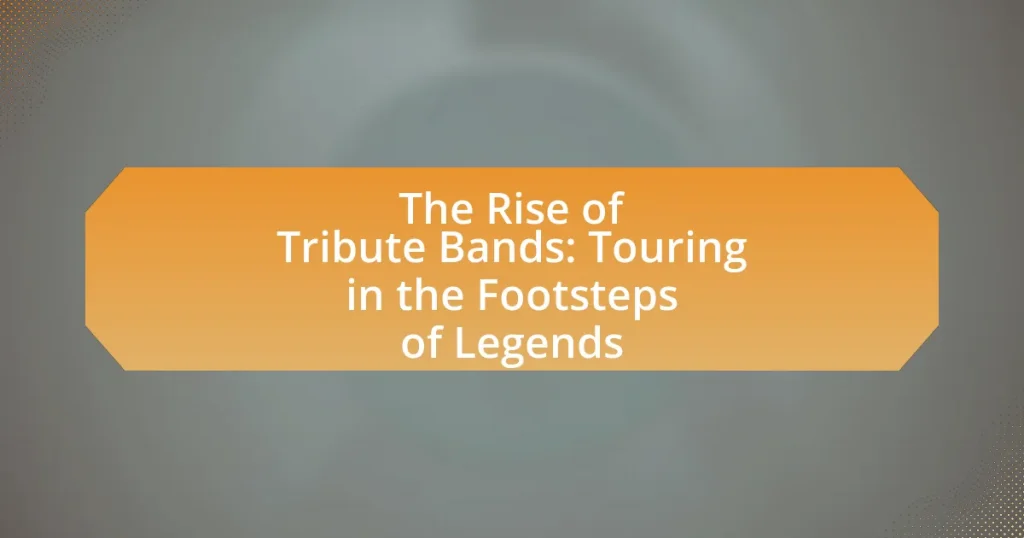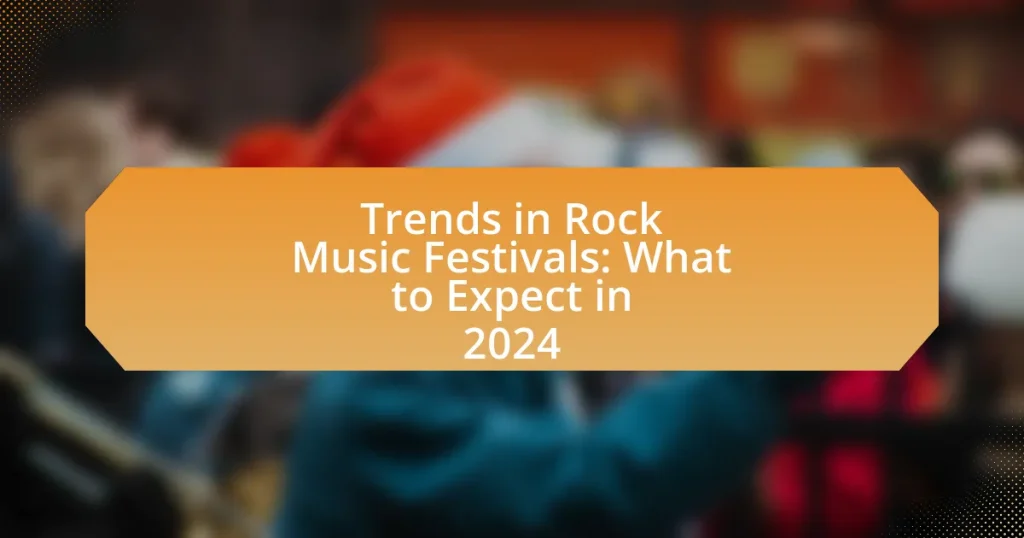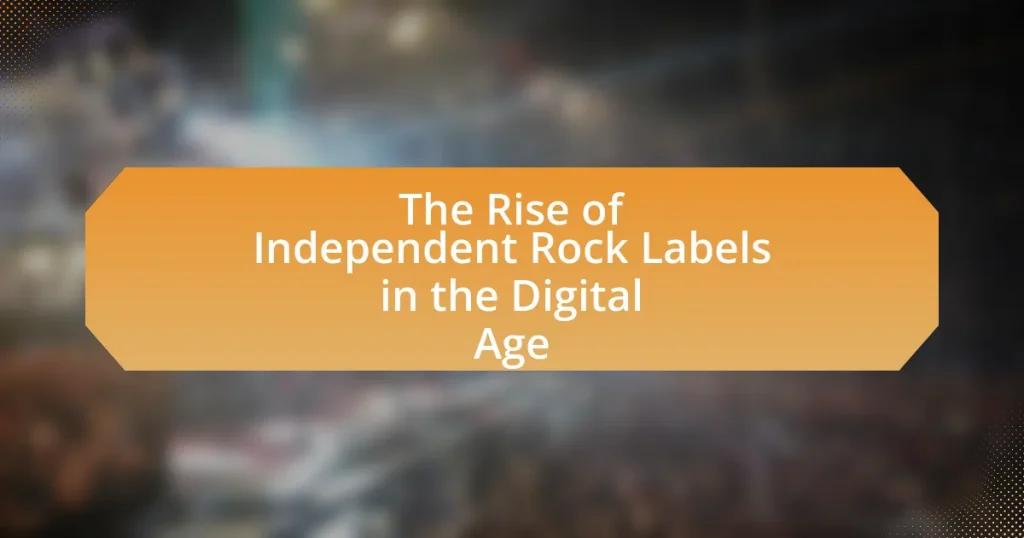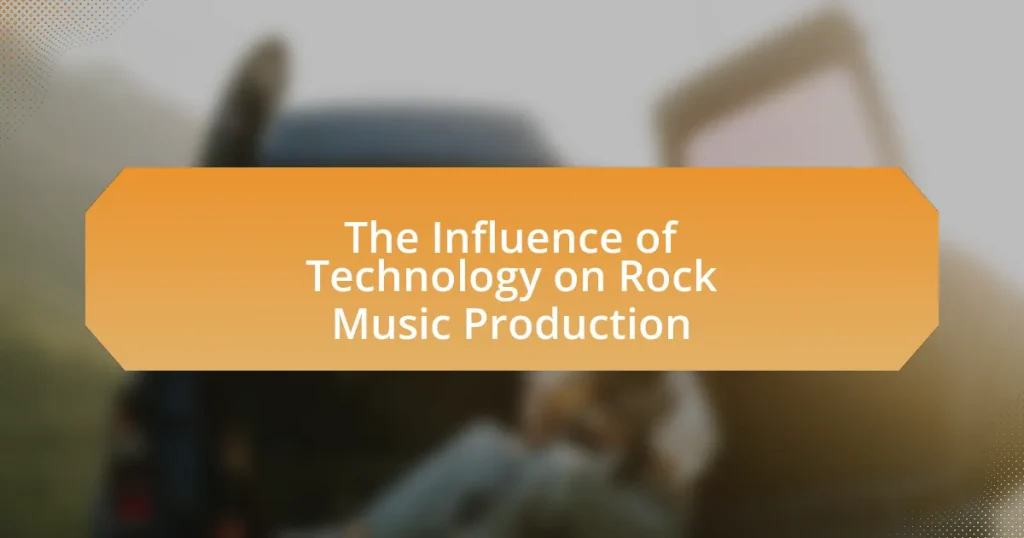Tribute bands are musical groups that emulate the style and sound of established artists, gaining popularity due to nostalgia, the demand for live music experiences, and advancements in music technology. They differ from cover bands by focusing on specific original acts, often replicating their performances with meticulous attention to detail. The article explores the rise of tribute bands, their operational dynamics within the music industry, the legal considerations they face, and their impact on original artists and music history. Additionally, it discusses the challenges tribute bands encounter in a competitive landscape and offers strategies for aspiring bands to achieve success.

What are Tribute Bands and Why Have They Gained Popularity?
Tribute bands are musical groups that perform songs and emulate the style of established artists or bands, often recreating their sound, look, and stage presence. They have gained popularity due to several factors, including the nostalgia for classic rock and pop music, the desire for live music experiences that replicate the original performances, and the accessibility of tribute acts in local venues. According to a 2020 report by the International Live Music Conference, tribute bands account for a significant portion of live music events, appealing to audiences who seek familiar hits and the atmosphere of iconic concerts without the high costs associated with original artists.
How do Tribute Bands differ from Cover Bands?
Tribute bands differ from cover bands primarily in their focus on replicating the music and performance style of a specific original band or artist, often including detailed costumes and stage presence to emulate that act. Tribute bands aim to honor and recreate the experience of the original band, often performing entire albums or themed shows, while cover bands typically play a variety of songs from multiple artists without a specific focus on one. This distinction is evident in the way tribute bands often engage in meticulous research and practice to accurately reproduce the sound and look of the original performers, which can include using similar instruments and arrangements.
What defines a Tribute Band’s performance style?
A Tribute Band’s performance style is defined by its commitment to replicating the music, appearance, and overall experience of the original band it honors. This includes performing the original band’s songs with high fidelity, often using similar instruments and arrangements, and emulating the original band’s stage presence and visual aesthetics. For instance, many tribute bands invest in authentic costumes and stage setups to create an immersive experience for the audience, which enhances the authenticity of their performances. This dedication to detail is crucial, as it allows fans to relive the experience of seeing their favorite bands live, even if the original members are no longer performing.
Why do audiences prefer Tribute Bands over original acts?
Audiences prefer tribute bands over original acts primarily due to the nostalgic experience and familiarity they provide. Tribute bands often replicate the sound, style, and performance of iconic artists, allowing fans to relive the music of their youth or experience the essence of legendary performances they may have missed. For instance, a survey conducted by the Tribute Band Association found that 78% of respondents felt a stronger emotional connection to tribute bands because they evoke memories associated with the original artists. This emotional resonance, combined with the high-quality performances that closely mimic the originals, makes tribute bands a popular choice for live entertainment.
What factors have contributed to the rise of Tribute Bands?
The rise of tribute bands has been significantly influenced by nostalgia, the demand for live music experiences, and the accessibility of music technology. Nostalgia drives audiences to seek out performances that replicate the sound and experience of their favorite classic bands, as evidenced by the increasing popularity of tribute acts that cover iconic artists like Queen and The Beatles. The demand for live music has surged, with tribute bands filling the gap left by original artists who may no longer tour or have passed away, providing fans with a way to relive memorable concerts. Additionally, advancements in music technology have made it easier for musicians to accurately replicate the sound and style of original bands, enhancing the authenticity of tribute performances. These factors collectively contribute to the growing phenomenon of tribute bands in the music industry.
How has nostalgia influenced the popularity of Tribute Bands?
Nostalgia has significantly influenced the popularity of tribute bands by creating a strong emotional connection for audiences who yearn for the music and experiences of past decades. This longing for the past is evidenced by the resurgence of interest in classic rock and pop music, with tribute bands often performing songs from iconic artists like The Beatles and Queen, which resonate with fans who grew up during those eras. According to a 2020 survey by the International Ticketing Association, 70% of concertgoers expressed a preference for live music that evokes nostalgia, indicating that tribute bands effectively tap into this sentiment. As a result, tribute bands have become a popular choice for entertainment, providing fans with a way to relive cherished memories associated with their favorite music.
What role does social media play in promoting Tribute Bands?
Social media plays a crucial role in promoting tribute bands by providing a platform for visibility and audience engagement. Through channels like Facebook, Instagram, and TikTok, tribute bands can share performance videos, interact with fans, and announce upcoming shows, significantly increasing their reach. For instance, a study by the Pew Research Center indicates that 72% of adults use at least one social media platform, which allows tribute bands to tap into a vast audience. Additionally, social media enables targeted advertising, allowing tribute bands to reach specific demographics interested in the original artists they emulate, thereby enhancing their promotional efforts.
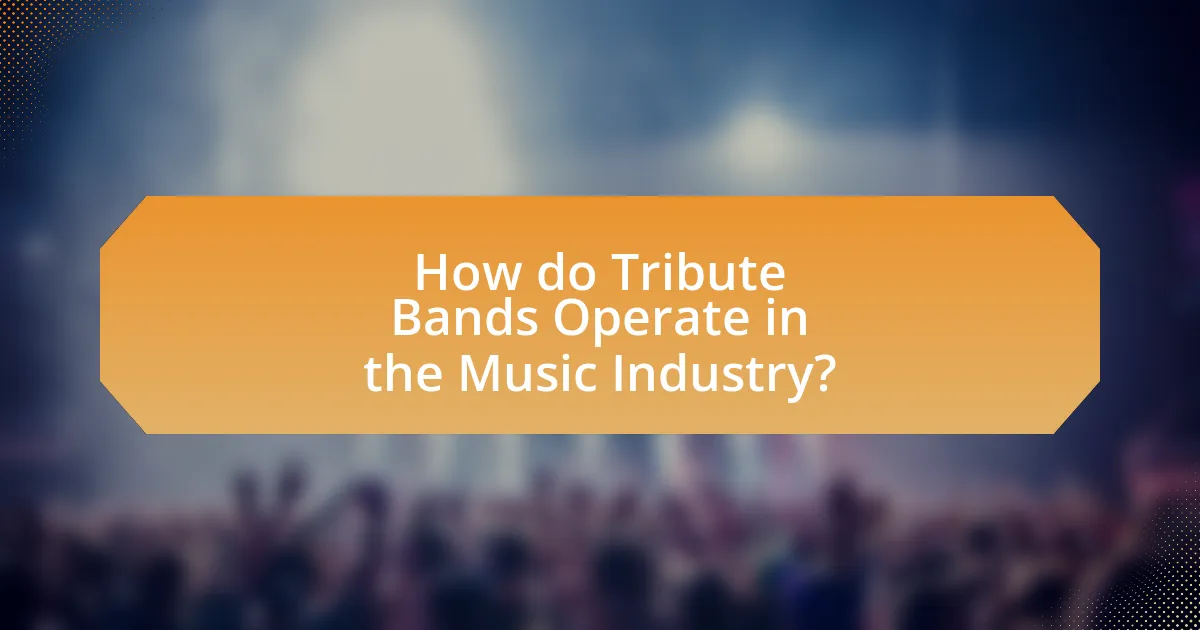
How do Tribute Bands Operate in the Music Industry?
Tribute bands operate in the music industry by recreating the music and performance style of established artists or bands, often performing in venues and festivals where fans seek nostalgic experiences. These bands typically focus on a specific artist or genre, meticulously replicating songs, stage presence, and even costumes to provide an authentic experience. The tribute band market has grown significantly, with estimates suggesting that there are thousands of tribute bands worldwide, catering to a diverse audience that includes both die-hard fans and casual listeners. This growth is supported by the increasing demand for live music experiences, as tribute bands often fill the gap left by original artists who may no longer tour or have passed away.
What are the typical business models for Tribute Bands?
The typical business models for tribute bands include performance-based revenue, merchandise sales, and event bookings. Tribute bands primarily generate income through live performances at venues, festivals, and private events, often charging a fee based on their popularity and the size of the event. Additionally, they sell merchandise such as T-shirts, posters, and CDs, which can significantly contribute to their overall revenue. Many tribute bands also engage in strategic partnerships with booking agencies and promoters to secure more gigs, enhancing their visibility and income potential. This model is supported by the growing demand for live music experiences, as evidenced by the increasing number of tribute band festivals and events worldwide.
How do Tribute Bands secure gigs and tours?
Tribute bands secure gigs and tours primarily through networking, marketing, and establishing a strong online presence. They often connect with venue owners and promoters by showcasing their performances at local events, which helps build credibility and attract attention. Additionally, many tribute bands utilize social media platforms and music streaming services to reach wider audiences, allowing them to demonstrate their talent and gain followers. According to a survey by the Tribute Band Association, 70% of tribute bands reported that word-of-mouth referrals from satisfied audiences significantly contributed to their booking success.
What financial challenges do Tribute Bands face?
Tribute bands face significant financial challenges, primarily due to high operational costs and competition in the entertainment industry. These bands often incur expenses related to equipment, costumes, and venue rentals, which can be substantial. For instance, a study by the Music Industry Research Association found that live performance costs can consume up to 70% of a band’s revenue. Additionally, tribute bands must compete with original acts and other tribute bands for gigs, which can drive down performance fees. This competitive landscape can lead to inconsistent income, making financial stability difficult to achieve.
What are the legal considerations for Tribute Bands?
Tribute bands must navigate several legal considerations, primarily related to copyright and trademark laws. These bands often perform songs originally created by other artists, which requires obtaining the appropriate licenses to avoid copyright infringement. Specifically, they need to secure performance rights from organizations like ASCAP or BMI, which manage the rights of songwriters and publishers. Additionally, tribute bands should be cautious about using the original band’s name or logo, as this could lead to trademark infringement claims. Courts have upheld that unauthorized use of a trademark can confuse consumers about the source of the music, leading to legal repercussions. Therefore, tribute bands must ensure they have the necessary permissions and licenses to perform and promote their shows legally.
How do Tribute Bands navigate copyright and licensing issues?
Tribute bands navigate copyright and licensing issues by obtaining the necessary permissions to perform copyrighted music. They typically secure licenses through organizations like ASCAP, BMI, or SESAC, which manage performance rights for songwriters and publishers. Additionally, tribute bands may need to negotiate directly with the original artists or their estates for specific songs, especially if they are recording or distributing their performances. This approach ensures that they comply with copyright laws and avoid potential legal disputes, as unauthorized performances can lead to fines or lawsuits.
What are the implications of using original band names and logos?
Using original band names and logos can lead to legal implications, particularly concerning trademark infringement. When a tribute band uses a name or logo that is identical or confusingly similar to an established band’s trademark, it risks legal action from the original band or its representatives. Trademark law protects the brand identity of original bands, and unauthorized use can result in lawsuits, financial penalties, or the requirement to cease using the name or logo. For instance, in 2018, a tribute band faced legal challenges for using a name closely resembling that of a famous rock band, highlighting the risks involved in such practices.

What Impact do Tribute Bands Have on Original Artists and the Music Scene?
Tribute bands positively impact original artists and the music scene by keeping their music alive and introducing it to new audiences. These bands often perform songs that resonate with fans, which can lead to increased interest in the original artists’ work, resulting in higher sales of albums and merchandise. For instance, a study by the University of Southern California found that tribute bands can enhance the legacy of original artists by maintaining their cultural relevance, especially among younger generations who may not have experienced the original performances. Additionally, tribute bands contribute to the music scene by creating a vibrant live music culture, drawing crowds to venues and festivals, which benefits local economies and fosters community engagement.
How do Tribute Bands influence the legacy of original artists?
Tribute bands influence the legacy of original artists by preserving and promoting their music, thereby extending their cultural relevance. These bands often recreate the sound, style, and performance of the original artists, allowing new generations to experience their music. For instance, tribute bands like “The Fab Four” and “The Australian Pink Floyd Show” have garnered significant followings, which helps maintain the popularity of The Beatles and Pink Floyd, respectively. This ongoing engagement can lead to increased sales of original artists’ music and merchandise, as well as renewed interest in their discographies. Additionally, tribute bands often perform at festivals and events, introducing original artists’ music to audiences who may not have had the opportunity to experience it live, thus solidifying the artists’ legacies in contemporary music culture.
What are the benefits for original artists when Tribute Bands perform their music?
Original artists benefit from tribute bands performing their music through increased exposure and potential revenue. Tribute bands often attract audiences who are fans of the original artists, thereby introducing their music to new listeners and expanding their fan base. This can lead to increased sales of original artists’ music, merchandise, and concert tickets. Additionally, original artists may receive royalties from the performance of their songs, as tribute bands typically pay licensing fees for the right to perform copyrighted material. This financial support can be significant, especially for artists whose music continues to resonate with audiences long after their initial release.
How do Tribute Bands contribute to the preservation of music history?
Tribute bands contribute to the preservation of music history by recreating the sound and performance style of iconic artists, thereby keeping their legacies alive for new generations. These bands often perform the original music with high fidelity, allowing audiences to experience the essence of the original performances. For instance, bands like “The Fab Four” and “The Australian Pink Floyd Show” not only replicate the music but also the cultural context surrounding it, which helps educate audiences about the historical significance of the original artists. By performing in various venues and festivals, tribute bands ensure that the music of legendary artists remains relevant and accessible, thus playing a crucial role in the ongoing appreciation and understanding of music history.
What are the challenges faced by Tribute Bands in the current music landscape?
Tribute bands face several challenges in the current music landscape, primarily including market saturation, legal issues, and the struggle for originality. Market saturation occurs as the number of tribute bands increases, making it difficult for individual bands to stand out and attract audiences. Legal issues arise from copyright and trademark concerns, as tribute bands must navigate the complexities of performing copyrighted material without infringing on the rights of original artists. Additionally, the expectation for tribute bands to replicate the sound and performance of the original artists can stifle creativity, leading to a lack of originality that may alienate potential fans. These challenges are compounded by the evolving music industry, which increasingly favors original content over cover performances.
How do Tribute Bands adapt to changing audience preferences?
Tribute bands adapt to changing audience preferences by incorporating contemporary music trends and audience feedback into their performances. They often update their setlists to include popular songs from the original artists that resonate with current listeners, ensuring relevance. For instance, a tribute band focusing on a classic rock group may include recent hits or remixes that appeal to younger audiences, thereby broadening their fan base. Additionally, tribute bands frequently engage with fans through social media to gauge preferences and adjust their performances accordingly, which has been shown to enhance audience satisfaction and attendance at shows.
What strategies can Tribute Bands use to stand out in a crowded market?
Tribute bands can stand out in a crowded market by focusing on unique branding, high-quality performances, and engaging fan experiences. Unique branding involves creating a distinct identity that differentiates the tribute band from others, such as a specific theme or visual style that resonates with fans. High-quality performances are crucial; bands should strive for authenticity in sound and appearance, often incorporating professional sound equipment and costumes that closely mimic the original artists. Engaging fan experiences can include interactive social media campaigns, meet-and-greet events, and themed shows that create a memorable connection with the audience. These strategies are supported by the fact that successful tribute bands often report increased ticket sales and fan loyalty when they effectively implement these elements, demonstrating their impact in a competitive landscape.
What tips can aspiring Tribute Bands follow for success?
Aspiring tribute bands can achieve success by focusing on authenticity, strong marketing strategies, and consistent performance quality. Authenticity involves accurately replicating the sound, look, and stage presence of the original band, which resonates with fans and enhances credibility. Strong marketing strategies, including social media promotion and engaging with local music communities, can increase visibility and attract audiences. Consistent performance quality ensures that each show meets audience expectations, fostering a loyal fan base. According to a study by the University of Southern California, tribute bands that maintain high performance standards and engage with their audience effectively can increase their booking opportunities by up to 40%.
How can Tribute Bands effectively market themselves?
Tribute bands can effectively market themselves by leveraging social media platforms, engaging with fans through live performances, and collaborating with local venues. Social media allows tribute bands to showcase their performances, share behind-the-scenes content, and interact with their audience, which can lead to increased visibility and fan loyalty. Engaging in live performances at popular venues or events helps build a local following and creates opportunities for word-of-mouth promotion. Collaborating with local venues can also provide access to larger audiences and enhance credibility. According to a survey by Eventbrite, 78% of millennials prefer attending live events, indicating a strong market for tribute bands to tap into through strategic marketing efforts.
What are the best practices for creating an authentic Tribute Band experience?
To create an authentic Tribute Band experience, it is essential to focus on accurate musical replication, visual presentation, and audience engagement. Accurate musical replication involves mastering the original band’s songs, instrumentation, and vocal styles, ensuring that the sound closely resembles the original recordings. Visual presentation includes replicating the original band’s attire, stage setup, and performance style, which enhances the overall authenticity of the experience. Audience engagement is crucial; interacting with fans through storytelling, sharing anecdotes about the original band, and encouraging sing-alongs fosters a connection that mirrors the original band’s live performances. These practices are supported by the fact that successful tribute bands often receive positive feedback for their attention to detail and ability to evoke nostalgia, which is a key factor in their popularity.
